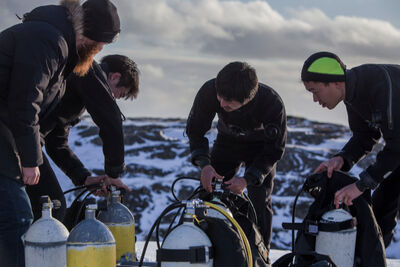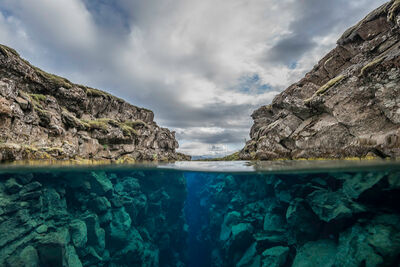Dry suit diving is all about making cooler diving experiences possible (in every sense of the word). Designed to keep you dry and warm, switching your wetsuit for a dry suit allows you to enjoy longer dives, discover cold water destinations and explore remote underwater sites. Keen to learn more? Read on for some dry suit diving advice from Rachel, our in-house dive instructor...
What is dry suit diving?
The clue's in the name when it comes to dry suit diving. These waterproof suits create an air-filled barrier between the diver and the water, offering thermal protection for cold-water exploration. With tight waterproof seals from your neck and wrists to your feet, the suits are designed to keep water out, making them ideal for chilly underwater adventures.

Should you give it a go?
Keen to try cold water diving? A dry suit is a great choice. Designed to keep you dry for extended periods of time, it opens up a wealth of underwater opportunities, from Iceland's glacial waters to the icy Arctic Ocean. The added warmth means longer dives with less fatigue (a win-win). Dry suits also offer protection from the wind and allow you to layer up with thermal undergarments for added comfort. Beyond cold conditions, they're also handy in warmer destinations, especially when diving multiple times in one day.
Time to suit up
Ready to take the plunge? The next step is to become qualified. Training is key when it comes to dry suit diving, to ensure you can control the air in your suit and manage your buoyancy. The SSI Dry Suit Diving specialty program covers everything from the benefits of dry suits to tips on handling underwater emergencies, while the PADI course offers information on different types of dry suits, how to repair them and how to dive safely.

Where to dive in a dry suit?
Now for the fun part: choosing your diving destination. For a bucket-list experience, Iceland's Silfra fissure in Thingvellir National Park awaits. You'll need a dry suit certification to dive between the North American and Eurasian tectonic plates, where water temperatures sit between two and four degrees Celsius (yikes). Head to the Galapagos Islands for the chance to encounter hammerheads, dolphins and spotted eagle rays, and don't miss the Azores, where the water teems with marine life, from manta rays to blue sharks. With cooler temperatures than divers might be used to in the tropics, dry suit diving is well worth considering for these destinations.
My dry suit diving experience
I felt dry underwater, for the first time in my life - a strange but incredible sensation. Even the most experienced divers need time to adjust to dry suits, and for me, the biggest surprise wasn't just looking like an astronaut ready for launch, but the lack of water seeping through my wetsuit. The waterproof layer made me feel truly invincible, until I had a dry suit leak, and suddenly things turned much soggier. The verdict? When there are no mishaps, it's an excellent (and essential) way of exploring colder waters. As for me, I think I'll stick to the balmy tropics for now…
















